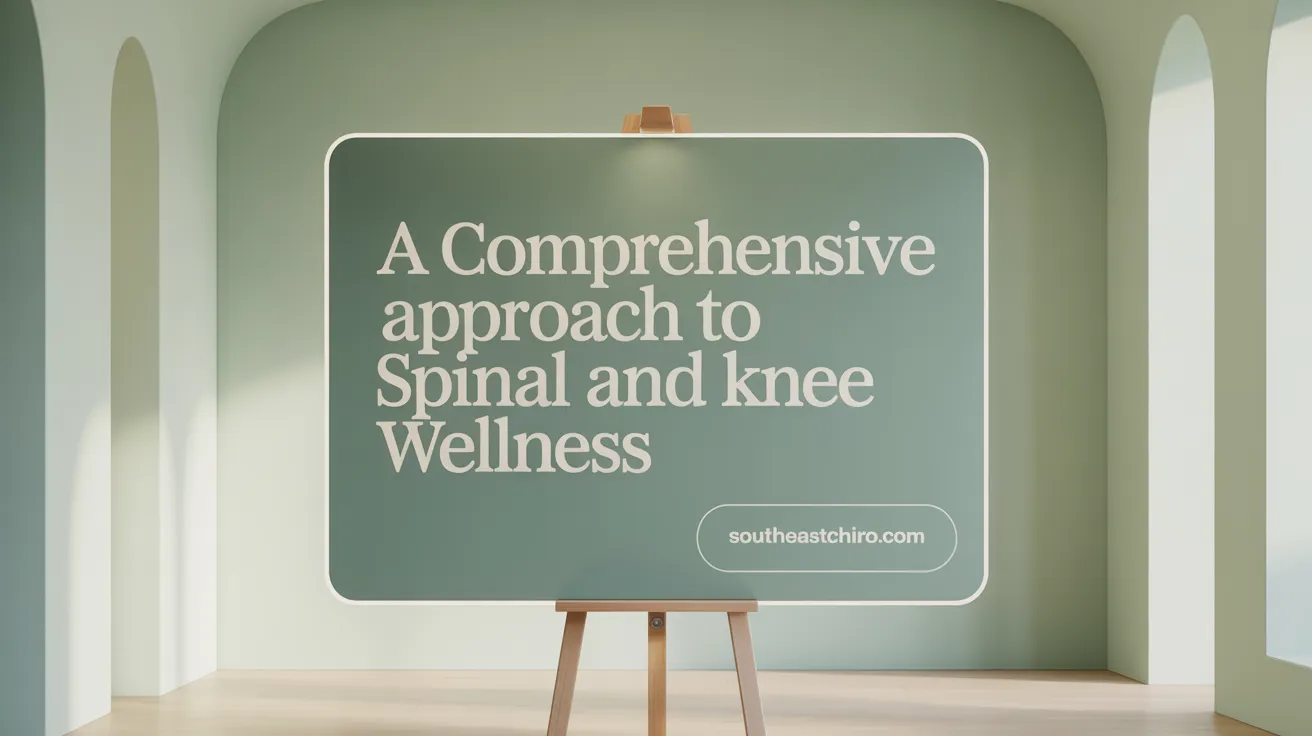Introduction to Knee Pain and Non-Surgical Care
Prevalence and Common Causes of Knee Pain
Knee pain affects approximately 25% of adults, with its prevalence rising significantly over the years. Common causes include osteoarthritis, ligament injuries such as ACL and MCL tears, meniscus damage, overuse, injury, and conditions like gout and bursitis. Aging, excess weight, and poor posture also contribute to knee discomfort.
Importance of Addressing Root Causes
Knee pain often stems from more than just local joint issues. Misalignments in the spine, hips, ankles, or pelvis can alter gait and create uneven pressure on the knee. Addressing these underlying factors is essential for long-lasting relief and proper joint function.
Overview of Non-Invasive Treatments Available
Non-surgical treatments aim to reduce pain, inflammation, and improve mobility without drugs or invasive procedures. These include chiropractic adjustments targeting joint and spinal alignment, soft tissue therapies like massage and instrument-assisted mobilization, therapeutic exercises for strength and flexibility, and advanced options such as low-level (cold) laser therapy. Together, they promote natural healing and often prevent the need for surgery or medication.
Holistic Chiropractic Approach to Knee and Spinal Health

What is the holistic approach to spinal health and wellness promoted by chiropractic practices?
Chiropractic care takes a holistic approach to spinal and overall musculoskeletal health by focusing on non-invasive healing approach and personalized treatments. Instead of just addressing symptoms, chiropractors aim to identify and treat the root causes of pain and dysfunction involving the spine, hips, knees, and ankles. This comprehensive strategy improves the body's structure and function to promote natural healing and maintain wellness.
Integration of spinal, hip, knee, and ankle adjustments
Chiropractors perform precise chiropractic adjustments for knee pain. This integration is vital because misalignments affecting knee pain can lead to altered gait, uneven joint stress, and pain. Correcting these misalignments helps restore proper joint mechanics and balance throughout the kinetic chain, improving joint mobility and reducing pain.
Role of manual therapies and lifestyle modifications in pain relief and mobility improvement
Manual therapies such as soft tissue therapy, massage, myofascial release, and instrument-assisted techniques complement adjustments by reducing muscle tension, improving circulation, and facilitating tissue healing. Chiropractors also provide tailored rehabilitative exercises to strengthen supporting muscles around the joints, which helps enhance stability and prevent future injuries.
Alongside therapy, lifestyle advice including ergonomics, posture correction, footwear recommendations, and stress reduction techniques empower patients to take control of their health and sustain improvements over time.
Benefits of improving overall neurological and immune function
By realigning joints and reducing spinal nerve irritation, chiropractic care can enhance nervous system function. This improved neurological balance supports better communication between the brain and body, influencing pain control, muscle function, and coordination.
Furthermore, reducing inflammation and promoting healthy movement boosts immune responses and tissue repair. This chiropractic holistic care for knee pain model strives to optimize not just musculoskeletal health but also the body's innate ability to heal and maintain long-term wellness.
Chiropractic Treatments and Techniques for Knee Pain Relief

What types of treatments are commonly offered by modern chiropractic practices?
Modern chiropractic care provides a variety of treatments tailored to each patient's unique needs. Commonly, chiropractic adjustments involve manual manipulation techniques of the spine, knee joint, hips, and ankles to correct misalignments that may contribute to knee pain. These adjustments often use high-velocity, low-amplitude thrusts to restore joint mobility and reduce nerve irritation.
What are common chiropractic methods for knee pain?
Chiropractors employ soft tissue therapies like massage and myofascial release to relax tight muscles and tendons around the knee, enhancing blood flow and easing muscle spasms. Rehabilitative exercises are integral, focusing on strengthening muscles such as the quadriceps and hamstrings to better support the knee and improve stability. These exercises are specifically designed to increase flexibility, reduce inflammation, and prevent future injuries.
What advanced chiropractic modalities help with knee pain?
Advanced techniques include low-level laser therapy (cold laser), which uses specific wavelengths of light to reduce inflammation and promote tissue healing. The McKenzie Method emphasizes patient engagement through targeted exercises that centralize and alleviate pain. Active Release Technique (ART) breaks down scar tissue and adhesions around the knee’s muscles and ligaments, while Instrument-Assisted Soft Tissue Mobilization (IASTM) uses specialized tools to detect and treat soft tissue restrictions, enhancing recovery.
How do tailored exercise programs and lifestyle guidance assist knee pain relief?
Chiropractors develop individualized exercise programs to strengthen muscles supporting the knee, improve joint alignment, and enhance range of motion. Lifestyle advice may include recommendations on proper footwear, posture correction, ergonomic modifications, and warm-up techniques to reduce strain during daily activities.
How does chiropractic care contribute to preventing surgery and medication dependence?
Chiropractic care offers a drug-free, noninvasive approach aiming to address root causes of knee pain by restoring joint function and promoting natural healing. This holistic care often helps patients avoid surgery and reduces reliance on pain medications by managing symptoms effectively through manual therapy, laser treatments, and rehabilitation exercises, facilitating quicker, safer recovery.
The Science and Application of Cold Laser Therapy for Knee Pain

How Does Low-Level Laser Therapy (LLLT) Work?
Cold Laser Therapy, also known as Low-Level Laser Therapy (LLLT) or Photobiomodulation Therapy (PBMT), uses specific wavelengths of light—primarily in the red to near-infrared spectrum—to stimulate healing deep within the tissues without heating or damaging the skin. The light energy penetrates the skin and is absorbed by the mitochondria within cells, enhancing ATP production. This boost in cellular energy supports tissue repair, reduces oxidative stress, and promotes anti-inflammatory biological processes. Additionally, LLLT encourages the release of endorphins that help naturally alleviate pain.
What Does Clinical Research Say About LLLT for Knee Osteoarthritis?
Clinical studies and meta-analyses have demonstrated that Low-level laser therapy for knee osteoarthritis can significantly relieve pain, reduce inflammation, improve joint mobility, and enhance functional status in patients with knee osteoarthritis. Specific wavelengths — for example, around 808 nm — have shown effectiveness in stimulating cartilage repair and improving muscle strength. Though clinical guidelines often recommend LLLT as an adjunctive therapy rather than a standalone treatment, its ability to reduce symptoms and aid recovery in musculoskeletal conditions is well documented.
What Are Typical Treatment Protocols and Benefits?
A typical Cold Laser Therapy Session lasts between 30 and 60 seconds per treatment area, with multiple sessions ranging from 8 to 30 treatments needed for optimal results. Benefits include decreased acute and chronic pain, reduced joint inflammation and swelling, faster wound healing, tissue regrowth, and improved blood circulation. Patients also report improvements in joint flexibility and pressure sensitivity. Because it is noninvasive and drug-free, LLLT serves as an attractive alternative for those seeking to avoid surgery or opioid use.
How Does Cold Laser Therapy Complement Chiropractic Care?
When integrated with chiropractic care, Cold laser treatment enhances the overall healing process. Chiropractors may combine spinal and knee joint adjustments with laser treatments and rehabilitative exercises. The combined approach addresses structural misalignments alongside cellular healing, offering a holistic path to managing knee pain and improving joint function.
What Limitations and Precautions Should Be Considered?
Despite promising results, cold laser therapy outcomes can vary depending on the individual's health, the specific laser parameters used, and correct application technique. Lack of standardized protocols and skepticism among some healthcare providers also limit widespread acceptance. Precautions include avoiding direct laser exposure to the eyes and contraindications such as epilepsy, cancer in the treatment area, and pregnancy. Cost and insurance coverage are additional considerations, as treatment sessions may be expensive without guaranteed results.
In summary, Cold Laser Therapy offers a scientifically supported, noninvasive method to relieve knee pain associated with osteoarthritis and other musculoskeletal disorders. Its use as part of a comprehensive chiropractic treatment plan can promote effective, drug-free pain management and improved joint health.
Class 4 Laser Therapy: Advanced Technology in Chiropractic Pain Management
Features and Benefits of Class 4 Laser Systems
Class 4 lasers, such as the Aspen Summit Laser and LightForce 15-watt laser, are powerful therapeutic devices used in chiropractic settings. These lasers emit near-infrared light that penetrates deeply into tissues, targeting muscles, ligaments, and joints. Their high intensity allows for more effective dosing compared to low-level lasers, accelerating cell regeneration and promoting faster healing. For more about Class 4 Laser Therapy and its benefits, see these resources.
How Deeper Tissue Penetration Enhances Healing
The advanced technology enables light to reach deep musculoskeletal structures, which leads to significant reductions in pain and inflammation. By energizing the mitochondria within cells, these lasers increase ATP production, speeding up tissue repair and reducing oxidative stress. This deep penetration also improves blood circulation and reduces nerve sensitivity, contributing to quicker relief and enhanced mobility. The mechanism of laser therapy pain relief and its effects on musculoskeletal conditions explain these processes in detail.
Therapeutic Applications
Class 4 laser therapy is widely used for managing arthritis symptoms, including osteoarthritis, by promoting cartilage repair and decreasing joint stiffness. It effectively treats ligament injuries, sports damage, and aids post-surgical recovery by accelerating wound healing and reducing scar tissue. Chronic pain conditions also benefit from this non-invasive treatment, which supports long-term management and prevents further tissue degeneration. You can learn more about laser therapy for chronic conditions and arthritis and its use in osteoarthritis knee treatment.
Treatment Sessions and Patient Experience
Typical sessions last between 5 and 20 minutes, depending on the condition's severity, with patients usually undergoing 5 to 12 treatments. Most patients describe the experience as painless, sometimes feeling gentle warmth or tingling. Many report noticeable improvements in pain and joint function within the first few sessions, highlighting the therapy's efficacy and comfort. For details on laser therapy session duration and what patients experience, see these articles.
Combining Laser Therapy with Chiropractic Care
Class 4 laser therapy complements chiropractic adjustments and rehabilitative exercises by preparing tissues for manipulation and enhancing recovery. Chiropractic care first addresses joint alignment and nerve function, while laser therapy focuses on healing and inflammation control. Together, they form a holistic approach that improves range of motion, strengthens muscles, and reduces pain more effectively than either treatment alone. For insights on chiropractic care with laser therapy and the benefits of laser therapy in chiropractic, see these resources.
Enhancing Patient Experience and Building Trust Through Chiropractic Websites

How do chiropractic websites enhance patient engagement and accessibility?
Chiropractic websites play a crucial role in improving patient engagement by providing clear, easy-to-understand educational content about treatments, conditions like knee pain, and wellness tips. This increases health literacy and empowers patients to make informed decisions about their care.
User-friendly design elements—such as intuitive navigation menus, mobile-friendly layouts, and straightforward online appointment scheduling—make it convenient for patients to connect with their chiropractor anytime and from any device. Educational resources like videos, comprehensive FAQs, and regularly updated blog posts deepen patient understanding and encourage proactive involvement in wellness.
These online features create an inviting digital environment that encourages continuous interaction and supports easy access to chiropractic care.
Why is trust important in the relationship between patients and chiropractic providers?
Trust is foundational in chiropractic care, as it directly affects patient satisfaction and how patients perceive their health outcomes. Patients who trust their chiropractor tend to be more open during consultations, closely follow treatment recommendations such as chiropractic adjustments or laser therapy for pain relief, and feel reassured about the safety and effectiveness of their care.
Though trust may have a moderate influence on subjective health perceptions, it is essential for creating a strong therapeutic alliance. Personalized communication, patience, and transparency about procedures like cold laser therapy or rehabilitation exercises build confidence and deepen this relationship.
High trust levels enhance satisfaction with care, foster ongoing patient engagement, and support long-term health and healing. This makes it imperative for chiropractic websites to communicate personalized care approaches clearly and foster transparency to build and maintain patient trust over time.
Long-Term Benefits of Chiropractic Care and Laser Therapy for Knee Health

Addressing Root Causes Including Spinal and Joint Misalignments to Prevent Recurrent Pain
Chiropractic care for knee pain focuses on realigning the spine, hips, ankles, and knee joints to correct misalignments affecting knee pain. Misalignments, especially in the lower back and pelvis, can alter gait and unevenly stress the knee, causing or worsening pain. By restoring proper alignment, chiropractors reduce nerve irritation and joint dysfunction, which helps prevent recurrent knee pain over time.
Muscle Strengthening and Rehabilitation for Joint Stability
Strengthening muscles surrounding the knee, such as the quadriceps, hamstrings, and gluteal muscles, is critical for stable joint function. Chiropractors tailor rehabilitative exercises to improve muscle support and enhance flexibility. This rehabilitation reduces strain on the knee structures, lessening the risk of injury and degeneration, and promotes long-term joint health.
Reducing Inflammation and Improving Circulation via Chiropractic Adjustments and Laser Therapy
Chiropractic manual therapies and cold laser therapy work synergistically to reduce inflammation and enhance blood flow. Laser therapy's photobiomodulation increases cellular ATP production, promoting tissue repair and reducing swelling. Adjustments improve joint mobility and stimulate circulation, facilitating nutrient delivery and waste removal. Together, these methods create an optimal environment for healing and sustained pain relief.
Avoiding Surgery and Medications Through Holistic and Drug-Free Methods
Both chiropractic care and laser therapy chiropractic treatment offer effective, non-invasive alternatives to surgery or opioid-based pain management. These treatments minimize side effects and encourage natural healing processes. Comprehensive care plans that include soft tissue therapies, exercise, and laser treatments aim to manage symptoms conservatively, helping many patients avoid invasive procedures and dependency on medications.
Expected Timeline for Improvements and Maintaining Knee Function
Patients often notice initial improvements within 2 to 4 weeks of consistent chiropractic adjustments and laser therapy. Significant functional gains and pain reduction commonly occur after 6 to 12 weeks. Ongoing maintenance with targeted exercises and periodic treatments supports continued knee mobility, strength, and prevention of future flare-ups, contributing to long-term knee health.
Conclusion: Integrating Chiropractic Care and Laser Therapy for Optimal Knee Pain Relief
Comprehensive Approach to Knee Pain
Chiropractic care offers a holistic approach that addresses the entire kinetic chain including spine, hips, knees, and ankles, ensuring that underlying causes of knee pain are treated rather than only symptoms. Treatments often involve joint adjustments, soft tissue therapies, rehabilitative exercises, and advanced modalities such as laser therapy.
Benefits and Safety of Laser Therapy
Low-level laser therapy (LLLT) or cold laser therapy is a safe, non-invasive treatment that stimulates healing at the cellular level by boosting ATP production, reducing inflammation, and promoting tissue regeneration. As part of a chiropractic care plan, laser therapy effectively reduces pain and enhances recovery for various knee conditions including osteoarthritis.
Patient Empowerment Through Education
Chiropractors emphasize patient engagement by providing tailored exercises, lifestyle guidance, and education to prevent future knee issues. Such empowerment fosters sustained knee health and supports functional mobility improvements.
Encouraging Personalized, Non-Invasive Care
Integrating chiropractic adjustments with laser therapy and individualized care plans encourages patients to avoid invasive surgery and reliance on medications, offering a natural, drug-free pathway to pain relief and improved quality of life.
Trusted Chiropractic Practice
Choosing skilled chiropractic professionals ensures precise diagnosis and treatment delivery, maximizing care outcomes and enhancing daily function for those living with knee pain.
